Introduction
Emacs’s SQLi mode can be a better replacement for the default terminal database client (psql, sqlite3,…). I prefer SQLi mode because it supports syntax highlighting (and also Postgres keyword) and allows me to flexibly choose which region in the buffer to send to the shell to execute.
SQLi is integrated by default in Emacs. The following interpreters are supported
- psql by PostgreSQL
- mysql by MySQL
- sqlite or sqlite3 for SQLite
- solsql by Solid
- SQL*Plus by Oracle
- dbaccess by Informix
- isql by SyBase
- sql by Ingres
- osql by MS SQL Server
- isql by Interbase
- db2 by DB2 (IBM)
- inl by RELEX
Make sure that the client you need to use can be located inside the Emacs’s PATH. You can install exec-path-from-shell package using package.el for Emacs to auto import the PATH from your default shell.
If you are using Mac OS, I have written a post about PostgreSQL installation and configuration steps on Mac here: Install and Config PostgreSQL on Mac.
Basic Usage
To use it, simply open an SQL buffer, M-x and then sql-postgres or
sql-mysql or whatever database system that you want to use. Input the server
information and password. A new SQLi buffer will be created and automatically
associated with the current SQL buffer. You can type the SQL command directly
into the SQLi buffer to execute or compose the command in the SQL buffer, select
it and then call the command sql-send-region (bound to C-c C-r by default)
to execute or sql-send-buffer (bound to C-c C-b by default) to execute all
the buffer.
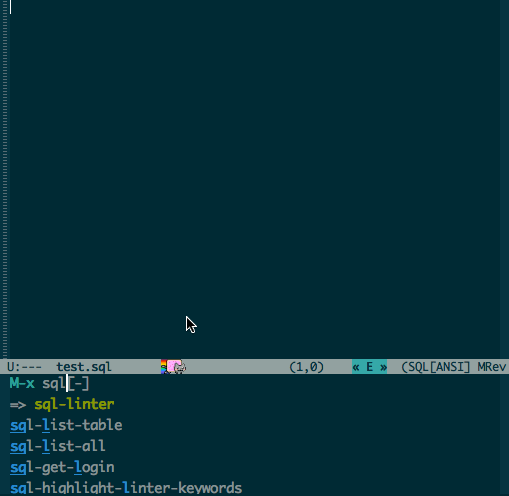
Basic Config
If you have one server that you usually connect to, you can set its login
parameters as default using the variables sql-***-login-params where *** can
be one of the database type that you want, for example
(setq sql-postgres-login-params
'((user :default "postgres")
(database :default "postgres")
(server :default "localhost")
(port :default 5432)))By default, when you enter SQLi mode, Emacs does not automatically truncate long lines. That can be hard for you to read the result returned from a table with many columns
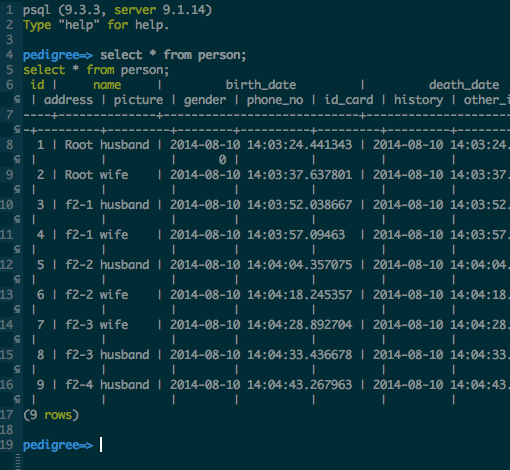
No line truncate
To fix this, call toggle-truncate-lines in sql-interactive-mode-hook.
(add-hook 'sql-interactive-mode-hook
(lambda ()
(toggle-truncate-lines t)))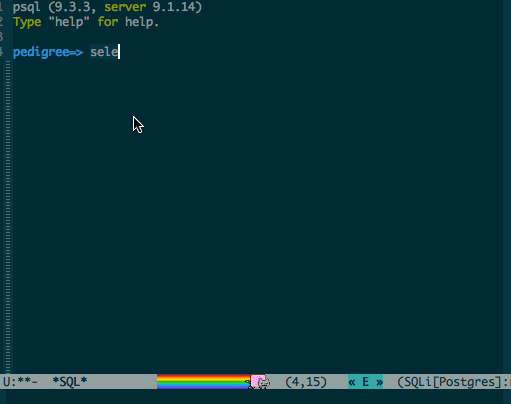
with line truncate
Helpful key bindings
There are many helpful key bindings in SQL interactive mode. You can use the
describe function feature in Emacs (C-h f) to view the documentation of
sql-interactive-mode. Some important keys to remember are
comint-previous-matching-input-from-inputandcomint-next-matching-input-from-inputto traverse through the input historysql-accumulate-and-indentif you want to type a multi-line command.
Connect to multiple server
If the default sql-postgres-login-params, sql-mysql-login-params,… do not
satisfy you, use the sql-connection-alist with the sql-connect function.
sql-connection-alist is an association list where the car of each
element determines the connection name and the cdr of those item indicates the
login params for that connection. For example
(setq sql-connection-alist
'((server1 (sql-product 'postgres)
(sql-port 5432)
(sql-server "localhost")
(sql-user "user")
(sql-password "password")
(sql-database "db1"))
(server2 (sql-product 'postgres)
(sql-port 5432)
(sql-server "localhost")
(sql-user "user")
(sql-password "password")
(sql-database "db2"))))Now, to connect to those server, call the sql-connect function with the input
argument is the connection name. You can make some interactive functions for
quickly connect to those servers
(defun my-sql-server1 ()
(interactive)
(my-sql-connect 'postgres 'server1))
(defun my-sql-server2 ()
(interactive)
(my-sql-connect 'postgres 'server2))
(defun my-sql-connect (product connection)
;; remember to set the sql-product, otherwise, it will fail for the first time
;; you call the function
(setq sql-product product)
(sql-connect connection))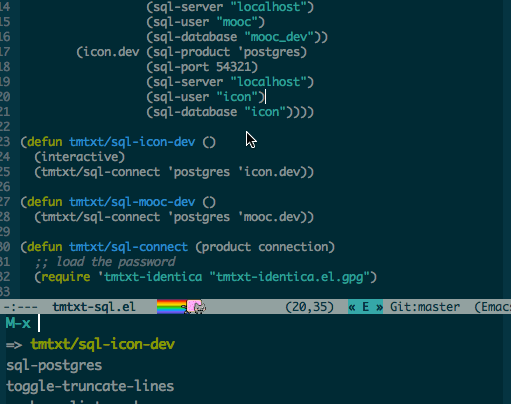
Encrypt password
Usually, you will put your config in .emacs under a version control system and backup it to a remote server so you will not want to store the password there. This post from emacs-fu gives me the idea of storing password in another file encrypted by GnuPG.
First, make sure you have GnuPG installed. Many Linux distros already come with GnuPG pre-installed. On Mac OS, you can install it using Macports
$ sudo port install gnupgCreate another file named my-password.el.gpg, make sure that it can be located
inside you emacs’ load-path. Add your password to that file like this. Make sure
the key of this alist is the same with the key you defined before in
sql-connection-alist (in this case server1 and server2).
(setq my-sql-password
'((server1 "password1")
(server2 "password2")))
(provide 'my-password)Save the file and choose the encryption method that you want, or just skip it to use the default symmetric encryption method.
Now, remove the password info in the sql-connection-alist and modify the
my-sql-connect function that we have defined in the previous step to load the
password from file
(setq sql-connection-alist
'((server1 (sql-product 'postgres)
(sql-port 5432)
(sql-server "localhost")
(sql-user "user")
(sql-database "db1"))
(server2 (sql-product 'postgres)
(sql-port 5432)
(sql-server "localhost")
(sql-user "user")
(sql-database "db2"))))
(defun my-sql-connect (product connection)
;; load the password
(require my-password "my-password.el.gpg")
;; update the password to the sql-connection-alist
(let ((connection-info (assoc connection sql-connection-alist))
(sql-password (car (last (assoc connection my-sql-password)))))
(delete sql-password connection-info)
(nconc connection-info `((sql-password ,sql-password)))
(setq sql-connection-alist (assq-delete-all connection sql-connection-alist))
(add-to-list 'sql-connection-alist connection-info))
;; connect to database
(setq sql-product product)
(sql-connect connection))When activated, the my-sql-connect function will prompt for the password to
decrypt the my-password.el.gpg file. However, it will ask for password just once and
only when you active the my-sql-connect function so that you will have to
enter the password just when you need to use it.
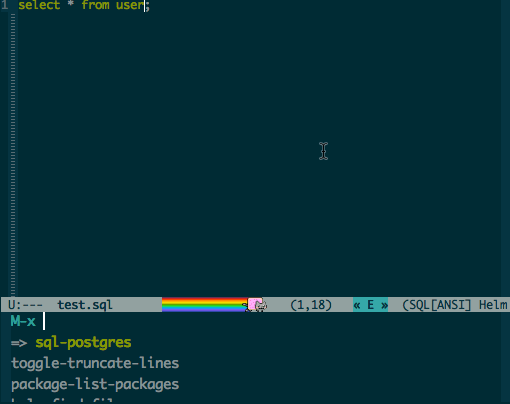
Extra: Fast database connecting and switching between buffers
We have all the necessary functions required for connecting to the database.
However, you still need to activate them through M-x or you can bind them to
some special key stroke but it will cost one key stroke for each server and will
result in too many key bindings that you need to remember. Even when you have
successfully connected to a server, switching between other buffers and sql
buffers is still very slow when you have many buffers opening. The solution is
using Emacs’ completing-read function or using
helm’s equivalent helm-comp-read
one. I will use the helm version for demonstration in this post but you can
easily convert it the normal Emacs’ completing-read function if you don’t use
helm.
For more information about helm, you can read on its
home page or read this
mini tutorial.
First, you need to define an alist for mapping the display names (completing
name) with the correct functions to connect to the database you want to execute
(in this case the my-sql-server1 and my-sql-server2 functions).
(defvar my-sql-servers-list
'(("Server 1" my-sql-server1)
("Server 2" my-sql-server2))
"Alist of server name and the function to connect")Next, define a function for reading the user input using that alist for completing
(defun my-sql-connect-server (func)
"Connect to the input server using my-sql-servers-list"
(interactive
(helm-comp-read "Select server: " my-sql-servers-list))
(funcall func))Now, bind that function my-sql-connect-server to a key binding that you want.
The first time you activate this function, it will prompt for a server name and
connect to that database server. Later when you activate this function again, it
will jump directly to the SQL interactive buffer that it has created before.
You can also activate this function when you are inside an sql buffer and that
buffer will automatically be associated with the interactive session. Calling
sql-send-region or sql-send-buffer will execute the sql command directly in
the sql interactive buffer.
However, now the problem is that sometimes you want to open multiple sql
interactive buffers, not just one. A solution for this is to use prefix
argument. Come back to modify the function my-sql-connect like this. Add a
condition before calling sql-connect function.
(defun my-sql-connect (product connection)
;; load the password
(require my-password "my-password.el.gpg")
;; update the password to the sql-connection-alist
(let ((connection-info (assoc connection sql-connection-alist))
(sql-password (car (last (assoc connection my-sql-password)))))
(delete sql-password connection-info)
(nconc connection-info `((sql-password ,sql-password)))
(setq sql-connection-alist (assq-delete-all connection sql-connection-alist))
(add-to-list 'sql-connection-alist connection-info))
;; connect to database
(setq sql-product product)
(if current-prefix-arg
(sql-connect connection connection)
(sql-connect connection)))After evaluating the above code, every time you call my-sql-connect-server, it
will connect to a server or switch to an interactive session if exists. Pressing
C-u prefix before activating that function will always create a new
connection to the database server that you choose.
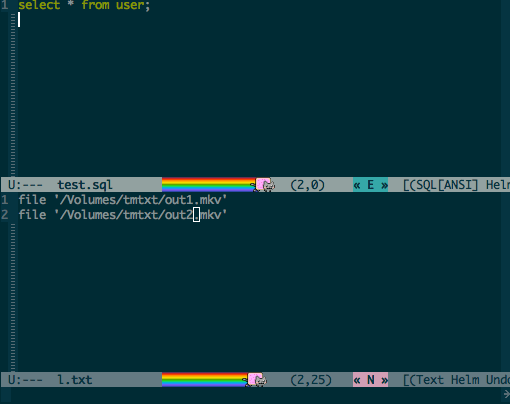
Sample Emacs config file
You can find the full code in my emacs config file on Github
